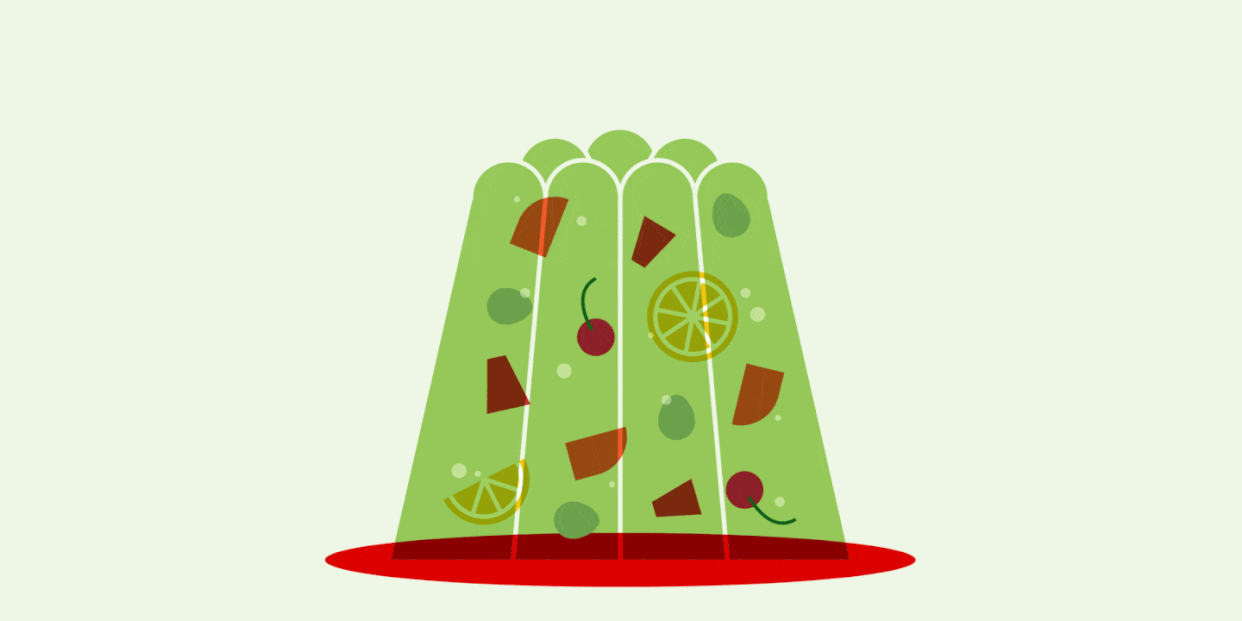Jell-O Haters Look Away, The Jiggly Salad Is Here To Stay

"Hearst Magazines and Yahoo may earn commission or revenue on some items through the links below."
The holidays are notorious for bubbling up memories around family and food. And for many people, especially those of us from the Midwest, some of these memories will inevitably be of Jell-O salad.
You know what I’m talking about. That bright, wiggly, artificially colored slime. The retro Jell-O salad is either presented as an unsightly mush of ingredients or as a mold of fruit suspended in gelatin. You could say I have conflicted feelings about it.
I used to gag as my grandma brought out dish after dish of marshmallow Jell-O salad. Then there was her Luncheon Shrimp Salad, which was lemon Jell-O, cream cheese, horseradish, and shrimp. Another one combined Jell-O with nearly every dairy product in the fridge. And then there was my mom’s favorite, a gooey mix of orange Jell-O, Cool Whip, cottage cheese, and mandarin oranges that allegedly tasted like a creamsicle.
I have memories of slyly dumping my Jell-O salads into the trash can. I had never really tasted any of her concoctions until I was well into my 20s, long after she died.
Some of her recipes have actually stuck around and show up at family dinners, whether out of nostalgia, tradition, remorse, or because they actually taste good. With Thanksgiving coming up, I started wondering how Jell-O and the space-age Jell-O salad became such a part of American holidays and food culture in the first place.
The Democratization of Gelatin
These days, some people would never think of using gelatin outside of making Jell-O shots. But gelatin used to be a household staple. Back in the Victorian age, long before Jell-O became “America’s Most Famous Dessert,” it was considered an ingredient for the elite.
“Before the invention of gelatin convenience products like Knox and Jell-O, these dishes were so labor-intensive that serving them pretty much proved you had a large kitchen of servants,” said Carolyn Wyman, author of Jell-O: A Biography - The History and Mystery of America’s Most Famous Dessert. “Jell-O democratized gelatin and made this previously high-end-only dessert available to the masses.”
Advertisements in the 1920s painted Jell-O as a luxury product that was attainable for working-class people. According to Wyman, this marketing played into Americans' desire to move up in class. But it wasn’t until after World War II that Jell-O salads had their moment.
“Jell-O salads first became popular in the 1930s but reached their highest expression as part of the processed food school of cooking that sprang up after the war,” said Wyman. This was an era of packaged foods and TV dinners, and it was the golden age of gelatin desserts. “As one of America's first convenience products, Jell-O blended right in with this trend and literally blended into the salads with other convenience foods like Minute Rice and Cool Whip.”
Housewives and working women like my grandmother relied on recipes that used these convenient food products. She was the queen of clipping recipes. She’d cut the wackiest recipes out of magazines and stuff them in her recipe boxes. Most of these dishes incorporated accessible products: Pillsbury Grands! Biscuits for her sausage and gravy; Cool Whip for her cranberry fluff; and of course Jell-O for her many gelatin molds and salads that would grace every holiday table. These dishes have become traditions in my family. They're not recipes by Pillsbury or Jell-O; they’re grandma’s.
Long Live The Jell-O Salad
“The real genius of Jell-O is that the ads and recipes have always been as moldable and adaptable as the food itself,” said Wyman. It was a blank canvas for creativity and reducing food waste. The identity of gelatin has changed so much, from a delicacy and status symbol to something accessible and convenient; from a diet food to a cheap ingredient only used for Jell-O shots and kids' food.
The history of Jell-O reflects our country's ever-changing attitudes toward food, status, health, and fashion, which I think means it’s bound to come back in style. And if all the restaurants serving up home-cooked meals reminiscent of childhood are a sign of our collective taste, we’ll always have an appetite for nostalgic dishes.
I now write about food for a living. I’ve spent more money on meals than I care to admit, and my friends often append the word snob when describing my tastes—food snob, beer snob, coffee snob. But price, trendiness, and quality don’t always imply good food. It’s also about the taste, the memories, which is why the Jell-O salad (and cranberry fluff and dip made from sour cream and Lipton’s soup mix) will always have a place on the table.
As we approach the holidays, I find myself hoping for a spread of Corningware dishes stuffed with brightly colored Jell-O and marshmallow salad. The salads are no longer made by my grandma, but the yellowed, food-splattered recipe cards are followed by my mom and dad. I’ll scoop it onto my plate next to my Sloppy Joes, thankful to be surrounded by food, family, and of course, the always present Jell-O salad.
You Might Also Like

